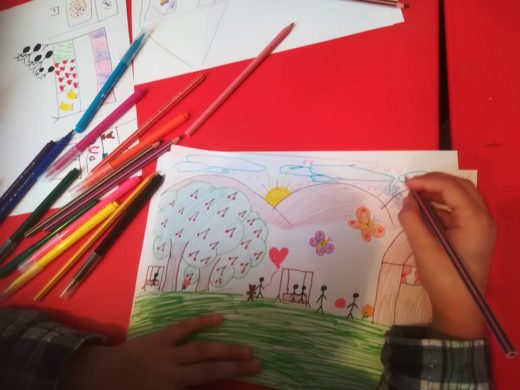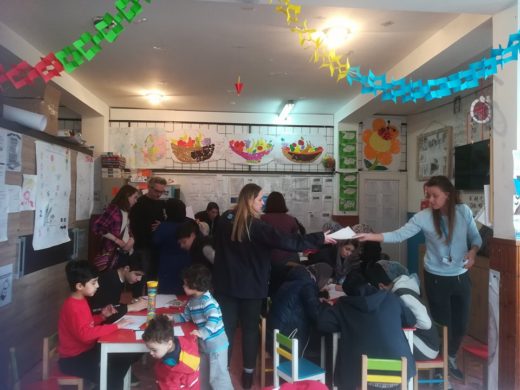On February 12 and 13, representatives of Yesterday/Today/Tomorrow project visited Serbia and, in cooperation with SOS Children’s Villages Serbia, organized art workshops for refugees in reception centers Adasevci, Principovac and Obrenovac. Drawings that were made by refugees on these workshops will be used on exhibitions all over the world and on Yesterday/Today/Tomorrow social media channels, in order to provide that voice and messages of refugees are heard.
“We are travelling around the world, visiting refugee camps and shelters and asking them to produce three drawings: one of their life before (Yesterday), one of their current life (Today) and one of their life imagined in the future (Tomorrow). The results of these drawings have been shared through the project’s social media accounts”, explained Brayan McCormack, Contemporary artist and founder of Yesterday/Today/Tomorrow project.
Through past two years McCormack and his colleagues visited over 30 refugee camps in 6 countries. Drawings that were made in these camps were part of a multidisciplinary installation created by McCormack at the Fondazione Giorgio Cini during the 2017 Venice Biennale and also were used on performances created in cooperation with Sheffield Hallam University.

“The idea of this project is to visualize the European refugee crisis and gives voice to a people who don’t have one. A singular voice for hundreds of thousands of people, from over 40 nationalities (speaking as many languages) in majority children. Every drawing is a voice. Each voice counts. We want to send unique visual message and we also have plan to work on analytical psychological study in cooperation with University in Rome, in which we want to explain what kind of emotions we can see from refugee drawings”, McCormack explained.
Speaking of drawings that he had chance to see by now, he said that large number of it shows fear, especially stress, horror and trauma that they experienced in boats, crossing by sea.
“We noticed that around 33% of drawings shows bright future, 33% bad future and 33% of refugees can’t see any kind of future. They just give me white piece of paper saying “I can’t draw anything, because I don’t know what the future will be.” They just have no idea what the future can be. And that is the most terrible thing of all”, said McCormack.

After Serbia, project team is going to visit refugee camps in Morocco and Sudan and to continue with gives voice to a people who don’t have one.
Elizabeth Pennington, journalist, project team member, student of the Sheffield Hallam University and author of the film about the project said that, according by drawings of refugees from Serbia, she thinks that the biggest problem for them is fact that borders are closed.
“Drawings that I saw today are very personal, touching and show many things, beautiful drawings telling about their history”, said her colleague, artist Stratis Vouyoucas.
Speaking about work of SOS Children’s Villages Serbia with refugees Elizabeth Pennington noticed “SOS Children’s Villages Serbia are doing really wonderful job and they really provide help for refugees. They try to provide stability and normality in extremely hard conditions and unnatural situation.”

“It seems that SOS Children’s Villages co-workers are very devoted and dedicated to their work. Just fact that you spent whole day with us, provided us help of translators and good work conditions says a lot. And that is wonderful”, agreed Stratis Vouyoucas.
Refugees who participated at art workshops in Serbia had very positive experience about it. They were very interested and with lot of attention, love and commitment made drawings about their past, present and future.













